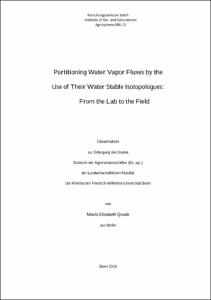Partitioning Water Vapor Fluxes by the Use of Their Water Stable IsotopologuesFrom the Lab to the Field

Partitioning Water Vapor Fluxes by the Use of Their Water Stable Isotopologues
From the Lab to the Field

| dc.contributor.advisor | Brüggemann, Nicolas | |
| dc.contributor.author | Quade, Maria Elisabeth | |
| dc.date.accessioned | 2020-04-26T19:07:36Z | |
| dc.date.available | 2020-04-26T19:07:36Z | |
| dc.date.issued | 04.09.2019 | |
| dc.identifier.uri | https://hdl.handle.net/20.500.11811/8002 | |
| dc.description.abstract | Water stable isotopes are powerful tracers for partitioning of the terrestrial ecosystem water vapor fluxes into process-based components, i.e. evapotranspiration (ET) into soil evaporation (E) and plant transpiration (T). The isotopic methodology for ET partitioning is based on the fact that E and T have distinct water stable isotopic compositions, which in turn are due to each flux being differently affected by isotopic kinetic effects. To use stable isotopologues of water in ET partitioning studies, a good knowledge of the isotopic (equilibrium and kinetic) fractionation effects is crucial. While the temperature-dependent equilibrium fractionation factor is well characterized (Majoube 1971), the kinetic fractionation factor (αK), relevant, e.g., during soil evaporation, needs further investigation. In order to address this knowledge gap, we conducted a series of three different long-term bare soil evaporation experiments (differing in soil-water availability and aerodynamic conditions) to obtain αK values from the collected isotopic data and the inversion of a well-known resistance-to-transfer model (i.e., the Craig and Gordon (1965) model). The isotopic composition of the soil water (δs) vapor was monitored non-destructively by using gas-permeable tubing (Rothfuss et al. 2013). The Craig and Gordon (1965) model was used in two different approaches. The first approach uses the Keeling (1958) plot to obtain values for the isotopic composition of the evaporation (δE). The second approach uses the slope of the linear regression between δs2H and δs18O. Results showed that the largest source uncertainty in the computation of αK stemmed from the uncertainty associated with the δE values modeled with the Keeling (1958) plot method. In the second approach αK values were within the theoretical range proposed by Dongmann et al. (1974) and Mathieu and Bariac (1996), which pointed to the prevalence of the turbulent transport of water vapor under saturated and unsaturated soil conditions. A variety of studies use different measurement techniques to estimate the isotopic composition of ET (δET), T (δT) and δE for ET partitioning at the field scale. Here, especially the long-term monitoring of δE and δT is challenging. For this, non-destructive soil water stable isotopic monitoring using gas-permeable material is a promising tool. We tested the method of Rothfuss et al. (2013) to measure δs in an ET partitioning field campaign during one growing season of sugar beet (Beta vulgaris). To evaluate this method, the estimates of the transpiration fraction (T/ET) obtained from non-destructive soil profiles (P) were compared to the destructive soil sampling (S). In addition, the isotope-based approach was compared to T/ET estimates obtained from the combination of micro-lysimeter and eddy covariance (EC) measurements. Results showed discrepancies between the δE values obtained from S and P, which are in line with recent findings for different sampling methods (Orlowski et al. 2016a, Orlowski et al. 2018). However, the mean absolute deviations found between isotope-based and lysimeter-based T/ET estimates were more than three times higher than the differences between S and P. This underlines the great potential of gas-permeable tubing for long-term monitoring in the field and calls for further investigation of the isotopic offsets between direct measurement and extraction methods. The long-term monitoring of δE by using gas-permeable material is only one challenge for ET partitioning studies. To provide sub daily estimates of T/ET, the long-term monitoring of δET and δT should be improved. Therefore, a review of the current and past literature was written about the progress and challenges of isotope-based ET partitioning. In total, we reviewed 31 studies and analyzed which methods provide the most promising approach for the long-term monitoring of δET, δT and δE. Next to gas-permeable material for the determination of δE, we encourage the development of experimental setups allowing for the determination of ET isotopic fluxes by combining EC measurements and high-frequency laser spectroscopy. The use of the gas-permeable material has also a great potential to measure δT. Albeit up to now only one study (Volkmann et al. 2016) showed that in-situ monitoring of δT in tree xylem is possible, this approach should be further developed for medium-sized plants (e.g. maize) and, in the longer term, thin-stem (cereal) plants. | en |
| dc.language.iso | eng | |
| dc.relation.ispartofseries | Schriften des Forschungszentrums Jülich. Reihe Energie & Umwelt ; 469 | |
| dc.rights | In Copyright | |
| dc.rights.uri | http://rightsstatements.org/vocab/InC/1.0/ | |
| dc.subject | water stable isotopologues | |
| dc.subject | source partitioning | |
| dc.subject.ddc | 550 Geowissenschaften | |
| dc.title | Partitioning Water Vapor Fluxes by the Use of Their Water Stable Isotopologues | |
| dc.title.alternative | From the Lab to the Field | |
| dc.type | Dissertation oder Habilitation | |
| dc.publisher.name | Universitäts- und Landesbibliothek Bonn | |
| dc.publisher.location | Bonn | |
| dc.rights.accessRights | openAccess | |
| dc.identifier.urn | https://nbn-resolving.org/urn:nbn:de:hbz:5n-55573 | |
| dc.relation.isbn | 978-3-95806-417-1 | |
| ulbbn.pubtype | Erstveröffentlichung | |
| ulbbnediss.affiliation.name | Rheinische Friedrich-Wilhelms-Universität Bonn | |
| ulbbnediss.affiliation.location | Bonn | |
| ulbbnediss.thesis.level | Dissertation | |
| ulbbnediss.dissID | 5557 | |
| ulbbnediss.date.accepted | 26.06.2019 | |
| ulbbnediss.institute | Mathematisch-Naturwissenschaftliche Fakultät : Fachgruppe Chemie / Institut für Anorganische Chemie | |
| ulbbnediss.fakultaet | Landwirtschaftliche Fakultät | |
| dc.contributor.coReferee | Amelung, Wulf |
Dateien zu dieser Ressource
Das Dokument erscheint in:
-
E-Dissertationen (1116)




